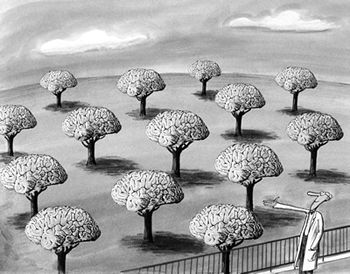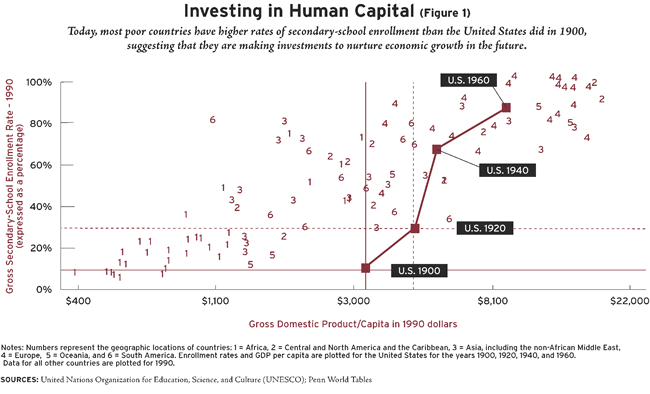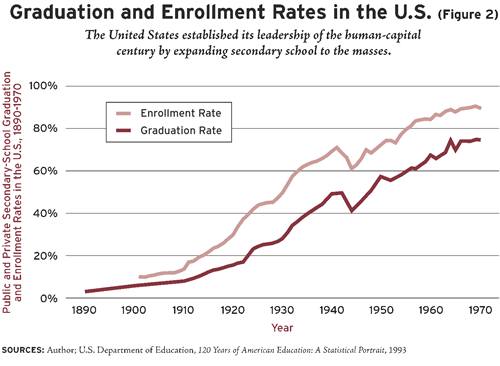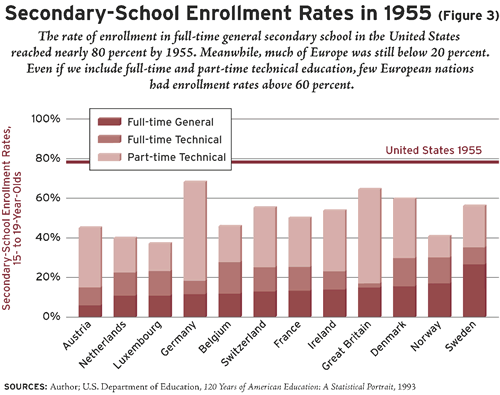 |
| Illustration by Claude Henri-Saunier.
|
The 20th century became the human-capital century. No nation today-no matter how poor-can afford not to educate its youth at the secondary-school level and beyond. Yet at the start of the 20th century even the world’s richest countries-richer than many poor nations are today-had not yet begun the transition to mass secondary-school education. With one notable exception: the United States.
The United States accomplished the feat of mass education by creating a new and unique education pattern or gauge-I will call it a “template”-that broke from the templates of Europe. The U.S. template was shaped by egalitarian institutions (a commitment to equality of opportunity); by the factor endowments of the New World (lots of land relative to labor); and by republican ideology, meaning democracy and pluralism.
For much of the 20th century this template was synonymous with a set of “virtues.” That is, the template consisted of characteristics that were virtuous. Among the virtues was mass secondary education that was:
• publicly funded,
• managed by numerous small, fiscally independent districts,
• open and forgiving,
• academic yet practical in its curriculum,
• secular in control, and
• gender neutral in its admissions.
I call these characteristics virtues because they promoted and furthered mass education and thereby increased social mobility and enhanced economic growth.
What brought about the human-capital century? Why and how did the United States lead the world in mass education for much of the 20th century? And what does this history mean for the future of education in the United States?
 |
The Human-Capital Century
Even poor countries today have a far greater rate of secondary-school enrollment than did the rich countries of the past. Consider Figure 1, on which the horizontal axis is real per-capita income in 1990 and the vertical axis is the rate of high-school enrollment in 1990. The lowest of the four points in the figure represents the real per-capita income and the high-school enrollment rate in the United States in 1900, just before the expansion of secondary-school education as a result of the U.S. “high-school movement.”
The northwest and southeast quadrants of Figure 1 relative to the data point for the United States in the year 1900 have unambiguous interpretations. I term the northwest quadrant the “good” quadrant and the southeast the “bad” quadrant. Nations found in the good quadrant had lower real per-capita incomes in 1990 than did the United States in 1900 but a higher enrollment rate in 1990 than the United States had in 1900. In other words, they are currently investing more in education relative to their per-capita income than the United States did at the beginning of the human-capital century. Their incomes may be low now, but they are making the investments necessary to nurture growth in the future.
By contrast, nations in the southeast quadrant, the bad quadrant, would have had higher per-capita incomes in 1990 than the United States did in 1900 but lower current enrollment rates than the United States had in 1900. In other words, their investment in education relative to their per-capita income would have been lower than in the United States at the turn of the century. Note that there are no nations in the bad quadrant and many nations in the good quadrant. One can do the same thought experiment for other years. Figure 1 also contains a data point for the United States in 1920. Once again, no country is located in the bad quadrant, the one with higher per-capita incomes and lower enrollment rates. The data point for 1940 places just a few countries in the bad quadrant. Only when the 1960 data point for the United States is considered do more than two or three countries fall into the southeast quadrant.
Two highly useful facts are embedded in these data and the thought experiment. The first fact is that secondary schooling took off in the United States from around 1910 to 1940. The second fact comes from the thought experiment. The bad quadrant is virtually empty until the point of comparison-the enrollment rate in the United States-reaches high levels. Meanwhile, the good quadrant is often brimming with countries. This suggests that even poor nations and poor people today are investing in education at higher rates than the United States did at the turn of the century. Thus the 20th century became the human-capital century. Nations can no longer afford to be left behind in educating their people because today’s technologies are produced by well-educated countries and are designed for an educated labor force.
The notion that skills matter, that the wealth of a nation is embodied in its people and that only an educated people can adopt new technologies (and adapt them and innovate them), was voiced in America at the dawn of the 20th century. In 1906 the governor of Massachusetts appointed a commission to study technical education and assigned the chairmanship to Carroll Wright, one of the greatest U.S. labor statisticians of all time, the first Massachusetts commissioner of labor, and the first commissioner of the federal Bureau of Labor Statistics. The report concluded, “We know that the only assets of Massachusetts are its climate and its skilled labor.” (Give the report’s author half credit.) The modern concept of the wealth of nations had emerged. What mattered was capital possessed by people-human capital.
The New Economy
In the 19th century, machines and natural resources, not people, mattered to the industrial giants-Britain, Germany, France, and the United States. It was not until the early 1900s that attention began to shift to the education of the people at the secondary and higher levels.
A “new” economy-as it was termed by contemporaries-had emerged in the early 20th century. It involved a greater use of science by industry, a proliferation of academic disciplines, a series of critical inventions and their diffusion (for example, small electric motors, the internal combustion engine, the airplane, various chemical processes), the rise of big business, and the growth of retailing. A host of demand-side factors increased the relative demand for educated labor and enhanced the returns to education and training.
These changes did more than increase the demand for a small cadre of scientists and engineers; they increased the demand for skilled and educated labor among the mass of workers. Firms began to seek employees with a host of general skills. They sought a white-collar and clerical staff capable of using the latest office machinery, with modern office skills (such as stenography and typing), polished grammar, and some mathematical prowess. They also sought blue-collar workers who could decipher manuals, who knew algebra, and who had a mastery of mechanical drawing and a familiarity with chemical and electrical fundamentals.
A remarkable notion had emerged around 1900: that schooling could make the ordinary office clerk, shop-floor worker, and even the farmer more productive. The odd thing is that even though most industrial nations acknowledged the change from physical capital to human capital, only one did much about it until well into the 20th century.
 |
U.S. Leadership
The demand for educated labor in the United States increased, and almost nationwide there was an outpouring of public and primarily local resources to build and staff high schools. These schools were academic (not industrial), free, secular, gender neutral, open, and forgiving. The education change was known then as the high-school movement. In the United States as a whole, the enrollment rate for youths in all secondary schools-public high schools, private secular and religious high schools, and the preparatory departments of colleges and universities-soared from 1910 to 1940 (see Figure 2). The graduation rate, expressed as a fraction of the relevant age group, also increased substantially during this period. In 1910 just one American youth in ten was a high-school graduate. By 1940, the median youth had a high-school diploma. It is no wonder that those who lived through the early part of the period described the change, in a 1914 report from the California Department of Public Instruction, as “one of the most remarkable educational movements of modern times.”
The high-school movement was not just an urban phenomenon. Nor was it just a New England phenomenon, though it began there. It spread quickly from New England towns to the rich agricultural areas of the Midwest and to the western states. Because the southern states had lower levels of education attainment for much of the 20th century and because the high-school movement diffused slowly throughout the South, the national data in Figure 2 give a somewhat misleading impression of the speed at which the high-school movement spread throughout the rest of the country. The spread of the high school was considerably faster in most other regions of the country, and graduation and enrollment rates were higher. Even before 1930 the graduation rate for 18-year-olds in many parts of the North, Midwest, and West exceeded 50 percent.
In 1910, when the data on graduation rates begin, New England was the leading region. But by the mid-1910s the rich states of the Pacific had closed in on New England. By the 1920s even the sparsely settled and agricultural states of the West North Central (states such as Iowa, Kansas, and Nebraska) had exceeded the rates achieved in New England. Only the Middle Atlantic states were left behind, and they caught up during the massive unemployment of the Great Depression, when jobs for teens evaporated overnight. In 1940, as the world braced for yet another war, America could boast of having the most educated workforce in the world. It accomplished this feat even though, for much of the period, it had open doors to the poor of the world. Its success in mass secondary education resulted from its education template and the associated virtues.
In contrast to the United States, the templates of Europe were characterized by quasi-public or private funding and provision; by the high standards of an unforgiving system; by the unity of church and state; and by a “boys come first” attitude. The German, British, and French systems, while different in their details, had much in common-strict standards, individual accountability, severe tracking at early ages, and higher education for a small, elite corps. Most of these systems had centralized bureaucracies and finances, and some had elaborate apprenticeship systems.
By the mid-1950s the U.S. lead in the human-capital century was astoundingly large. A wide gap existed between Europe and the United States in the education of youth. Across the 12 European countries reported in Figure 3, only one, Sweden, had a full-time, general education enrollment rate for 15- to 19-year-olds that exceeded 20 percent. Just two nations had a full-time general and technical education enrollment rate that exceeded 30 percent. The U.S. enrollment rate for the same age group in 1955 was almost 80 percent. Even if one added to the European data youths in part-time technical education, enrollment rates would still be considerably lower than in the United States. Only in the past three decades has the difference between the secondary-school enrollment rates of the United States and Europe been largely eliminated. As a consequence, the lower quality of U.S. secondary-school education has become a major domestic issue in the United States.
Why did the United States at the turn of the 20th century break from the education and training templates of Europe and pioneer a novel form of secondary education? Why did Europeans believe that Americans were “wasting” resources by educating their masses? Why did Americans reject a highly specific, on-the-job, industrial form of education (such as the British, Danish, and German apprenticeship systems) in favor of one that was general, school-based, and academic? The answers to these questions concern basic differences between the New World and the Old World.
Formal, general education is more valued when geographic mobility and technical change are greater. School, not an apprenticeship and on-the-job training, enables a youth to change occupations over a lifetime, to garner skills different from those of his or her parents, and to respond rapidly to technological change. The U.S. template was not wasteful in the technologically dynamic, socially open, and geographically mobile New World setting. In fact, it probably enhanced the dynamism of the New World.
In short, a host of changes beginning in the late 19th century increased the demand for certain skills and knowledge. A set of republican institutions enabled the United States to respond to the increased demand for skill. Together with a set of New World preconditions (such as a high ratio of land to labor), these favorable circumstances led the United States to respond to the technological imperative in a particular way. By the early 20th century the United States began to endow a large fraction of its youth with skills in formal, school-based, academic settings, using a system termed here the U.S. template. The United States achieved mass secondary (and later mass higher) education because of a set of virtues. The virtues enabled the supply-side institutions to respond to the demand-side shift.
How did the virtues accomplish so much? Take the virtue of decentralization, for example. If public support for school expansion were less than 50 percent in a state, the existence of numerous small, fiscally independent districts would enable high schools to diffuse. People choose where to live, and small districts are generally more homogeneous than large districts with respect to income, ethnicity, religion, and cultural values. It is likely, therefore, that individual preferences for public goods are more similar the smaller the geographic area is. Greater homogeneity means that the public good-education in this case-might be funded by some of the districts, whereas there would be no funding if the district were the size of the state. In much of Europe, in contrast to the United States, decisions about education were highly centralized. In Britain and France, for example, national legislation was required to fund expansion of secondary education, and initially it spread more slowly there than in the United States.
About 130,000 separate school districts existed around 1925, but many were tiny common school districts of the open country, and some did not have the ability to set their own tax rates. That still left tens of thousands of fiscally independent school districts large enough to have established a public secondary school. These relatively small, fiscally independent school districts implicitly competed with one another to attract residents.
In work that Larry Katz and I have done using archival records from a unique state census, we found that an additional year of high school at the start of the high-school movement in 1915 added more than 12 percent to the earnings of young men (18- to 34-year-olds). This return was almost double that of a year of secondary school in 1955. Returns were substantial even within various occupations. That is, even if a youth were somehow destined to be a blue-collar or a white-collar worker, there would still be significant returns to further education. The return to education, furthermore, was as high for farmers as it was for those in non-agricultural occupations.
What impact did the U.S. template have on economic growth and individual welfare? Consider the change in economic inequality. As more individuals were educated in the first half of the 20th century, inequality declined. The structure of wages narrowed, wage ratios for higher-skilled relative to lesser-skilled positions fell, and the returns to education decreased. All of the data sets I have examined show declining inequality for the period from the late 1910s to the 1950s. They also show rising inequality after the mid-1970s. If we think of the wage structure as being the result of a race between technology and education, then education ran faster than technology in the first half of the century, and technology ran faster than education in the second half. Interestingly, technology does not appear to have accelerated after the 1970s. Instead, advances in attainment of education slowed down.
 |
Have Our Virtues Become Vices?
The U.S. system of education for much of the 20th century was characterized by what I have called virtues. The U.S. template succeeded during the first half of the 20th century and for some time after, performing better than those of other nations. The system produced far more educated citizens and workers. It did not, by and large, reinforce class distinctions. Instead, it enabled economic and geographic mobility and resulted in a large decrease in inequality in economic outcomes. It may also have increased technological change and thus labor productivity, although that is far more difficult to prove.
The virtues I have mentioned include: education that was publicly funded and provided, an open and forgiving system, an academic yet practical curriculum, numerous small, fiscally independent school districts, and the secular (not church) control of schools. However, these characteristics are no longer seen as uniformly virtuous. To some they now constrain, rather than further, education. For example:
• Public or community funding and public provision were the hallmarks of the common school system. Now, however, vouchers-public funding but private provision-and charter schools are being used and considered for use to increase competition.
• An open and forgiving system without tracking at early ages was seen as egalitarian and nonelitist. But this type of system is now viewed as lacking standards and accountability. Almost all states today have standards for promotion from one grade to the next, high-school graduation, school funding, and teacher retention. Some of these standards are strict and have serious consequences for those who do not pass.
• A general, academic education for all may enhance flexibility at the beginning, but may, in the end, leave many behind. It may have worsened rising inequality in the 1980s. Some have recently espoused technical and vocational training for certain youths.
• Although a decentralized system of small, fiscally independent districts competing for residents once fostered investments in education, this system is now seen as producing serious funding inequities. Most states now have equalization plans, but some plans (such as that in California) have led many to exit the public system and may actually reduce spending per child in poor districts.
• The separation of church and state encouraged a “common” education for all. However, an insistence on the secular control of public funds meant that Catholic and other church-based schools could not receive publicly funded vouchers, even in academically failing school districts where other private schools are unavailable to poor students. The recent Supreme Court ruling in Zelman v. Simmons-Harris may widen the use of vouchers by denominational schools, not just by those in failing school districts.
In short, the nation appears to be abandoning many of the very virtues that catapulted the United States to the summit of the human-capital century. It is possible that these attributes were virtues only at a time when the nation had a very particular need-to bring general, formal education to the masses. Now they may be vices as the nation attends not only to the number of children in school, but also to the quality of the education they are receiving. A whole new set of virtues may arise in the 21st century, qualities that focus the nation on education performance and student achievement.
For now, the nation appears confused about which attributes to elevate to the status of virtue. In the past, the decentralized nature of the education system was a virtue in the sense that it promoted higher enrollment rates. Today, reformers still pin their hopes on other strategies that count on the power of decentralized decisionmaking, such as school choice, charter schools, and vouchers. By contrast, the standards and testing of the accountability movement are centralizing power within the system and creating a more uniform curriculum at the state level. Likewise, efforts to equalize funding across school districts place more financial responsibility at the state level while removing financial discretion from localities. There are potential pitfalls in all of these approaches. For instance, before moving ahead with voucher plans that involve religious schools, the nation needs to think harder about separating theology from geology, geometry, and biology. Likewise, although funding disparities among school districts may be unjust, removing local fiscal incentives may alienate suburban taxpayers and erode their support for public education. Without caution and care, today’s new virtues may become vices as well.
-Claudia Goldin is a professor of economics at Harvard University. This article is adapted from an address given on June 19, 2002, at the Federal Reserve Bank of Boston’s 47th annual conference series. A different version is forthcoming in the conference proceedings, Education in the 21st Century: Meeting the Challenges of a Changing World.


